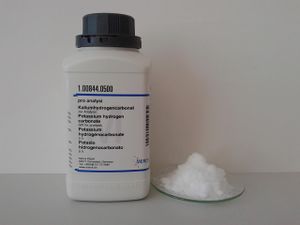Difference between revisions of "Potassium bicarbonate"
(→Relevant Sciencemadness threads) |
|||
| Line 66: | Line 66: | ||
| pKb = | | pKb = | ||
| Solubility = 33.7 g/100 mL (20 °C)<br>60 g/100 mL (60 °C) | | Solubility = 33.7 g/100 mL (20 °C)<br>60 g/100 mL (60 °C) | ||
| − | | SolubleOther = Insoluble in alcohols, [[benzene]], [[chloroform]] | + | | SolubleOther = Reacts with acids<br>Insoluble in alcohols, [[benzene]], [[chloroform]], [[toluene]] |
| Solvent = | | Solvent = | ||
| − | | VaporPressure = | + | | VaporPressure = ~0 mmHg |
}} | }} | ||
| Section3 = {{Chembox Structure | | Section3 = {{Chembox Structure | ||
Revision as of 22:17, 16 July 2018
 Potassium bicarbonate, slightly wet, on a watch glass.
| |
| Names | |
|---|---|
| IUPAC name
Potassium hydrogen carbonate
| |
| Other names
Potassium acid carbonate
| |
| Properties | |
| KHCO3 | |
| Molar mass | 100.115 g/mol |
| Appearance | White hygroscopic salt |
| Odor | Odorless |
| Density | 2.17 g/cm3 |
| Melting point | 292 °C (558 °F; 565 K) (decomposes) |
| Boiling point | Decomposes |
| 33.7 g/100 mL (20 °C) 60 g/100 mL (60 °C) | |
| Solubility | Reacts with acids Insoluble in alcohols, benzene, chloroform, toluene |
| Vapor pressure | ~0 mmHg |
| Acidity (pKa) | 10.329 |
| Thermochemistry | |
| Std enthalpy of
formation (ΔfH |
-963.2 kJ/mol |
| Hazards | |
| Safety data sheet | AcrosOrganics |
| Flash point | Non-Flammable |
| Lethal dose or concentration (LD, LC): | |
| LD50 (Median dose)
|
> 2000 mg/kg (rat, oral) |
| Related compounds | |
| Related compounds
|
Potassium carbonate |
| Except where otherwise noted, data are given for materials in their standard state (at 25 °C [77 °F], 100 kPa). | |
| Infobox references | |
Potassium bicarbonate or potassium hydrogen carbonate is a hygroscopic colorless salt of potassium with the formula KHCO3.It is used as a food additive in the European Union, E 501. It can be found in nature as the rare mineral kalicinite.
Contents
Properties
Chemical
Potassium bicarbonate decomposes to potassium carbonate if heated above 290 °C, despite some sources claiming the decomposition occurring at 100 or 120 degrees C.
- 2 KHCO3 → K2CO3 + CO2 + H2O
Potassium bicarbonate, like its sodium counterpart will react with acids to form potassium salt of the said acid.
- KHCO3 + HCl → KCl + H2O + CO2
Physical
Potassium bicarbonate is a white hygroscopic solid, soluble in water but insoluble in alcohols.
Availability
Potassium bicarbonate is sold by winemaking stores as a pH regulator/buffer. It is more expensive than sodium bicarbonate.
Some low-sodium baking powders may contain potassium bicarbonate, though most have calcium or magnesium carbonate, so always read the label.
Preparation
Potassium bicarbonate can be made by bubbling carbon dioxide into a solution containing potassium carbonate.
If you have a mixture of potassium and sodium hydroxide, you can dissolve it in alcohol and then bubble excess carbon dioxide in the solution. As potassium bicarbonate is insoluble in alcohol, it will precipitate, while sodium bicarbonate will stay in solution.
Projects
- Make potassium salts
- Buffering agent
- Fungicide
Handling
Safety
Potassium bicarbonate is considered safe and doesn't require special handling.
Storage
In closed bottles. Since it's hygroscopic, it's best to keep it in a desiccator.
Disposal
No special disposal is required. Discard it as you wish.
References
Relevant Sciencemadness threads
- Articles containing unverified chemical infoboxes
- Chemical compounds
- Inorganic compounds
- Potassium compounds
- Acid salts
- Bicarbonates
- Bases
- Amphoteric compounds
- Hygroscopic compounds
- Materials unstable in acidic solution
- Easily prepared chemicals
- Readily available chemicals
- Materials available as food grade
- Edible chemicals
- Minerals